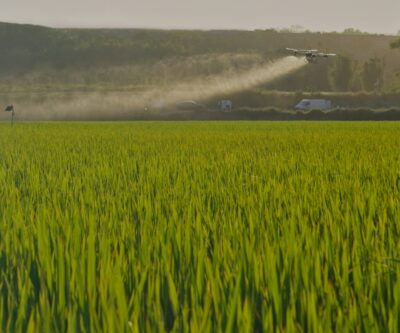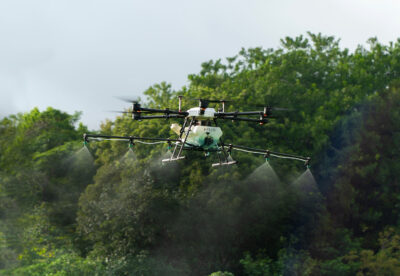With unmanned chemical application becoming big business, there is increasing pressure on operators to cover larger areas quicker than ever before.
With this shift towards productivity over safety operators are failing to properly mitigate spray drift leading to off-target application, damage, and costly law suits.
Spray Drift refers to the movement of pesticide droplets or particles away from the target area during or after application. There are two primary types of spray drift – PARTICLE and VAPOUR drift.
Definition
Particle drift occurs when spray droplets, typically larger in size, are carried away from the target area by wind or air currents during application.
Key Characteristics
 Droplet Size – Larger droplets (usually above 100 microns) are more prone to particle drift, especially if they are not sufficiently heavy enough to fall straight to the ground. Many wetting agents also produce smaller droplets.
Droplet Size – Larger droplets (usually above 100 microns) are more prone to particle drift, especially if they are not sufficiently heavy enough to fall straight to the ground. Many wetting agents also produce smaller droplets.
Wind Influence – Wind speed and direction plays a significant role in particle drift. Higher wind speeds can carry droplets further away from the target area.
Application Factors – Nozzle type, spray pressure, and application height and speed affects droplet size and susceptibility to drift. Fine mist and high-pressure applications are more likely to result in particle drift.
Mitigation Strategies
Using Larger Droplets – Employing nozzles that produce larger droplets can reduce drift potential. Drift retardant additives are also available to reduce spray drift.
Lowering Boom Height – Keeping the spray boom closer to the target reduces the distance droplets can drift.
Reducing Flight Speed – Lowering the speed of application allows the rotor system to force droplets down to the target.
Wind Speed Monitoring – Avoiding application during high winds or using windbreaks can minimise drift.
Definition
Vapour Drift occurs when volatile pesticides evaporate into a gaseous form and move away from the target area with air currents.
Key Characteristics

Volatility of Chemicals – Pesticides with high vapour pressure are more prone to vapour drift. The chemical formulation plays a crucial role in volatility.
Post Application – Vapour drift can occur both during and after application as the pesticide evaporates from the target surface.
Mitigation Strategies
Choosing Low Volatility Products – Selecting pesticides with low vapour pressures reduces the risk of vapour drift.
Temperature and Timing – Applying pesticides during the cooler parts of the day or under stable atmospheric conditions (low wind and moderate temperatures) can help reduce drift.
Formulation Changes – Using formulations designed to minimise volatility, such as emulsifiable concentrates or water-based solutions, can mitigate vapour drift.
Summary
Both types of spray drift can have significant environmental impacts, affecting non-target plants, animals, and ecosystems. Proper understanding and management of these drift types through appropriate application techniques, timing, and product selection are essential for effective and responsible pesticide use.
Spray drift when using agricultural spray drones can be influenced by various factors. These factors can be categorised into environmental conditions, application techniques, and equipment characteristics. We will look at some of the key contributors to each of these factors in the next section.
Environmental Conditions
It is essential that environmental conditions are constantly monitored and spraying operations only occur during appropriate times. Wind, temperature, and humidity all play a critical role in the management of spray drift.
High Wind Speed – Increases the potential for spray droplets to be carried away from the target area.
Inconsistent Wind Direction – Can cause unpredictable drift patterns, making it difficult to control where the spray lands.
High Temperatures – Can cause spray droplets to evaporate quickly, leading to vapour drift.
Low Humidity – Also increases evaporation rates, making droplets smaller and more prone to drift.
Inversions – Occur when a layer of warm air traps cooler air near the ground, preventing spray from settling and causing it to drift horizontally over long distances.
Rainwater – Will dilute chemical and can result in chemicals entering storm drains and waterways. Check the product label before use and the weather forecast for the area. Most chemicals will have an exclusion period before and after rainy weather to mitigate the potential for runoff.
Application Techniques
In addition to environmental conditions, the way in which the aircraft is flown can have a considerable impact on spray drift management. As operators and manufacturers push to cover larger areas in shorter times, drones are being flown higher and faster than ever before – often to the detriment of spray drift safety.
High flight speeds can cause the spray pattern to become uneven and increase the likelihood of drift as the droplets are dispersed over a wider area.
Trailing vortices from the rotor system of an RPA at high speed can cause droplets to swirl and lift in a “dragon tail”. This increases the time the droplets are airborne, increasing the potential for particle drift.
Did you know? The Department of Primary Industries (DPI) in NSW recommends a flight speed no greater than 18kph (5m/s) for effective drift management.

Dragon Tail effect caused by excessive flight speed
Flying too high above the target surface increases the time droplets are airborne, giving them more opportunity to drift before reaching the target.
Did you know? The Department of Natural Resources and Environment (NRE) in Tasmania prohibits chemical release from a drone any higher than 3 meters above target.
Higher pressure settings produce finer droplets, which are more susceptible to drift. Lowering the pressure can help produce larger droplets that settle more quickly.
Did you know? Fluid pressure is critical when using TeeJet style nozzles as different pressures produce different droplet sizes with the same nozzle. Charts are available to help select the correct nozzle for your system.
Spray Weather Meter – On site monitoring of weather conditions can help operators avoid high risk conditions with real-time information. A good option is the Kestrel 3550AG Weather Meter.
Weather Apps – Alternatively, weather apps such as BOM, Willy Weather, and Windy provide guidance for daily weather patterns via stations positioned or located in strategic regional areas. These are monitored 24/7 and are capable of long-term forecasts of up to 7 days.
Equipment Characteristics
The design of the spray system on an agricultural RPA can have a huge impact on drift management. Careful consideration should be given to nozzle types and location as well the pattern of air movement around rotor systems. Bigger booms and more nozzles is not always the answer!
Nozzle Type – Different nozzles produce different droplet sizes and patterns. Selecting the right nozzle for the specific application can reduce drift. This is particularly important when using TeeJet style nozzles as droplet sizes are fixed and pressure dependant, unlike CDA style nozzle that can be adjusted in the air.
Droplet Size – Larger droplets are less prone to drift, so nozzles that produce larger droplets can help minimise drift. Unless specifically directed by the product label, larger droplet sizes are always preferable for RPA applications, especially where a high flight speed is important.
Boom Length – Extending booms in an attempt to increase swath width can move the nozzles into turbulent air outside of the rotor downwash. This can cause poor spray vortices and increase drift.
Boom Stability – Stable boom design ensures consistent application patterns and minimises fluctuations that can lead to uneven spraying.

Poor boom design on a homemade drone
Flight Path Accuracy – Precise navigation and stability systems help maintain a consistent flightpath, ensuring even application and reducing the risk of drift caused by sudden movements.
Gyroscopic Stabilisation – Helps keep the drone steady in varying wind conditions, contributing to consistent spray patterns.
Summary
Effectively managing spray drift with agricultural drones requires careful consideration of environmental conditions, application techniques, and equipment characteristics.
By understanding and controlling these factors, operators can achieve a more precise and efficient pesticide application, reducing the risk of environmental contamination and ensuring better crop protection.

